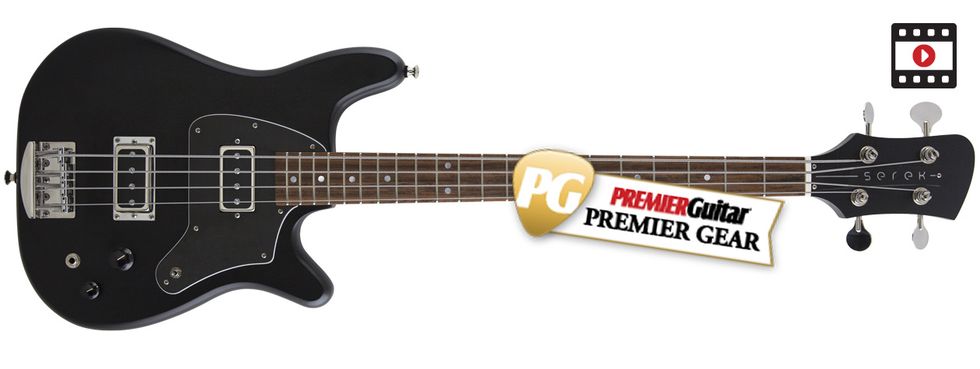Clip 1 - Neck pickup, tone at 20 percent.
Clip 2 - Both pickups, tone at 70 percent.
Clip 3 - Bridge Pickup, tone at 30 percent.
Chicago luthier Jake Serek, the former Lakland bass craftsman, has developed his own take on vintage-inspired basses by combining passive electronics with clean, cool looks. Serek’s latest design is the Midwestern 2, an adaptation of his original short-scale line that brims with understated sophistication.
Midwestern Topography
The original Midwestern bass was influenced by Serek’s procurement of a ’60s Epiphone Newport. While he appreciated many aspects of the Newport, Serek knew he could make improvements to the quirky instrument.
Developing the Midwestern 2, Serek made the lower horn smaller, carved a deeper cutaway, and added an extra fret. Like its predecessor, the Midwestern 2 employs a 1-piece mahogany body and a 2-piece, quartersawn-mahogany neck. Our review bass featured a jatoba fretboard upgrade, but pau ferro and Indian rosewood are the standard fretboard options.
Darkstar pickup fans will be pleased to know that Serek employs a single Guild BS-1 as the stock pickup, though he also offers a nice selection of other choices, including the proprietary line of pickups he has developed. On our tester Midwestern 2, a pair of his handwound, wax-potted Singles were installed. The single-coil pickups are manipulated with a simple control setup consisting of two knobs (volume and tone) and a 3-way pickup switch.
Additional features consist of a bone nut, Hipshot hardware, and a "satin faded black" finish. While Serek offers other options, this particular grouping of components gave our Midwestern 2 tester loads of tonal versatility and a pretty badass look.
Monster of the Midway
The Midwestern 2 impressed right out of the case. It was remarkably light at 6 1/2 pounds, which made my back smile with anticipation. The satin finish and sleek demeanor made for the perfect aesthetic combo and evoked fun nicknames for the bass like “Darth Vader” and “Raider Bass.”
Ratings
Pros:
Full-bodied tone and great playability in a cool, comfy package. Simply a very impressive short-scale bass.
Cons:
Slight balance issue when strapped. Pricey.
Tones:
Playability:
Build/Design:
Value:
Street:
$2,100
Serek Midwestern 2
serekbasses.com
But the Midwestern 2 is way more than just a pretty face. In a seated position, the bass balanced very well on the thigh or between the legs, like a classical guitar. It did, however, rest at a horizontal position when worn on a strap. This won’t be an issue for those who prefer this orientation, but it would have been nice for it to stay balanced at different angles.
The playability was seemingly effortless, as the neck shape and fretboard radius provided a comfortable platform for string skipping and smooth shifting. Every fret was accessible and the deep cutaway invited explorations of the upper portions of the instrument. Not only that, the Midwestern 2 had an uncanny broken-in feel, as if I’d been playing it for years.
Serek’s Singles pickups sounded fantastic, despite the expected 60-cycle hum that comes with single-coils. Soloing the neck pickup revealed tones reminiscent of a Gibson EB, with full lows, scooped articulate mids, and harsh-free highs that accentuated finger attack. Balancing both pickups delivered a Rickenbacker-meets-Jazz bass sound, providing stronger high-mids and tight lows. The bridge pickup on its own didn’t deliver sounds as bark-y as a Jazz bass, but it produced an authoritative, pointed timbre that would still please Jaco disciples.
The tone control did a great job shaping the sonic qualities of the Serek single-coils. I experimented with the dial in depth at a songwriter jam, where different bass sounds were required for the various tunes. For example, by dialing down the tone control and soloing the neck pickup for a country ballad, the Midwestern 2 delivered a thick, warm tone with great sustain—ideal for recording in this genre. A funk tune required some slap work, so I engaged both pickups and set the tone at about 70 percent. Though it may not have delivered a completely spot-on, funky Jazz Bass sound, it had a deep, aggressive tone that worked quite well. Going from chart to chart, it was evident the Midwestern 2 could be used in almost every musical setting thrown its way.
The Verdict
Short-scale basses have enjoyed a noticeable rise in popularity over the last few years, and the Midwestern 2 is a shining example of what makes these little rascals such a blast to play. Serek has created a portable instrument with big, articulate tones and supreme playability. Professionals might well find its vintage voice invaluable in the studio and onstage, while weekend warriors will consider it to be … well, pretty damned fun. Serek may be the new kid on the block, but it seems he is already planting his flag near the top of the short-scale mountain. If you’re looking for a bass that will inject some fun and fire into your playing, give the Midwestern 2 a good look.
Watch the Review Demo:









![Rig Rundown: AFI [2025]](https://www.premierguitar.com/media-library/youtube.jpg?id=62064741&width=1245&height=700&quality=70&coordinates=0%2C0%2C0%2C0)












 Shop Scott's Rig
Shop Scott's Rig


![Rig Rundown: Russian Circles’ Mike Sullivan [2025]](https://www.premierguitar.com/media-library/youtube.jpg?id=62303631&width=1245&height=700&quality=70&coordinates=0%2C0%2C0%2C0)












































